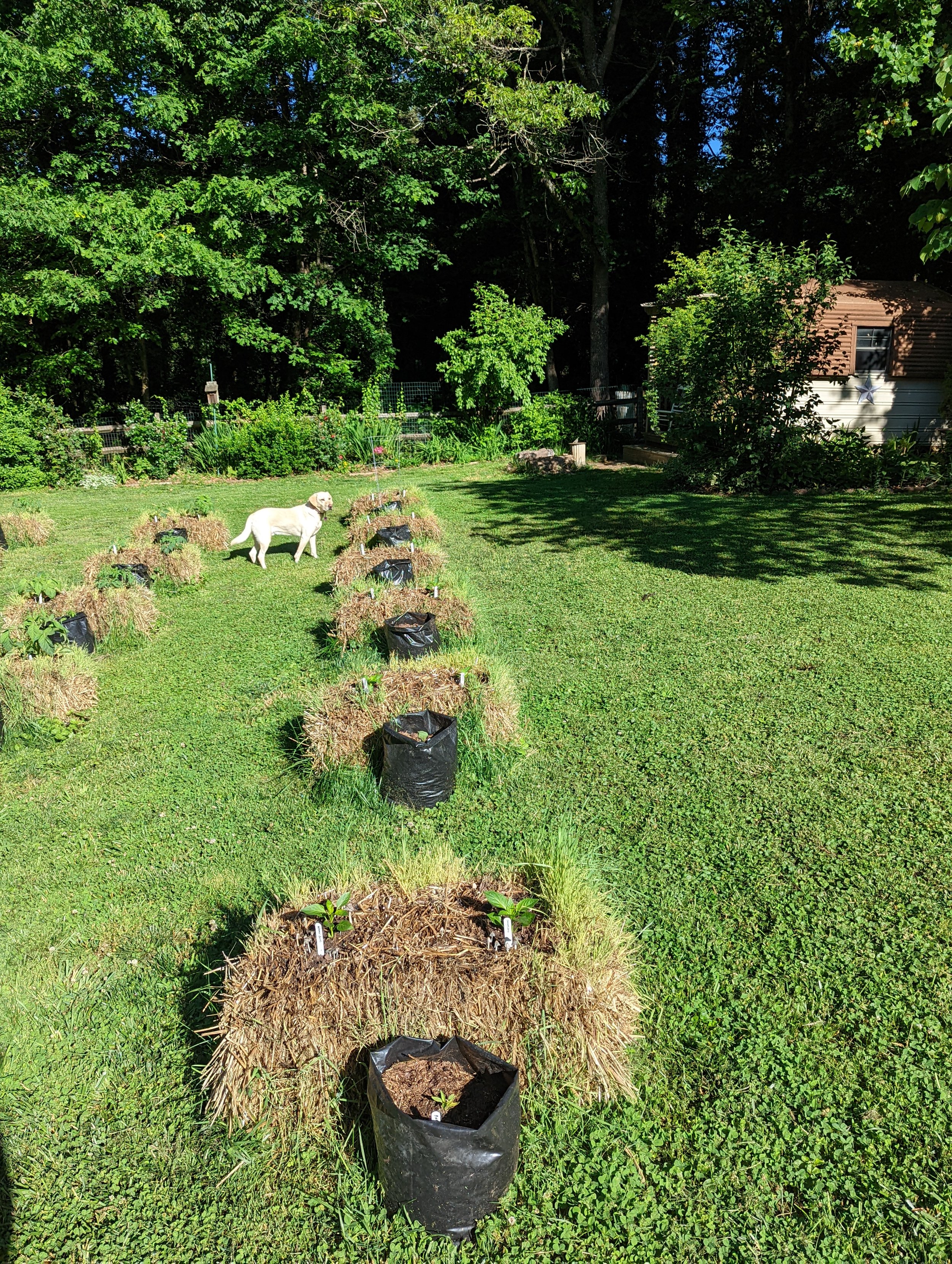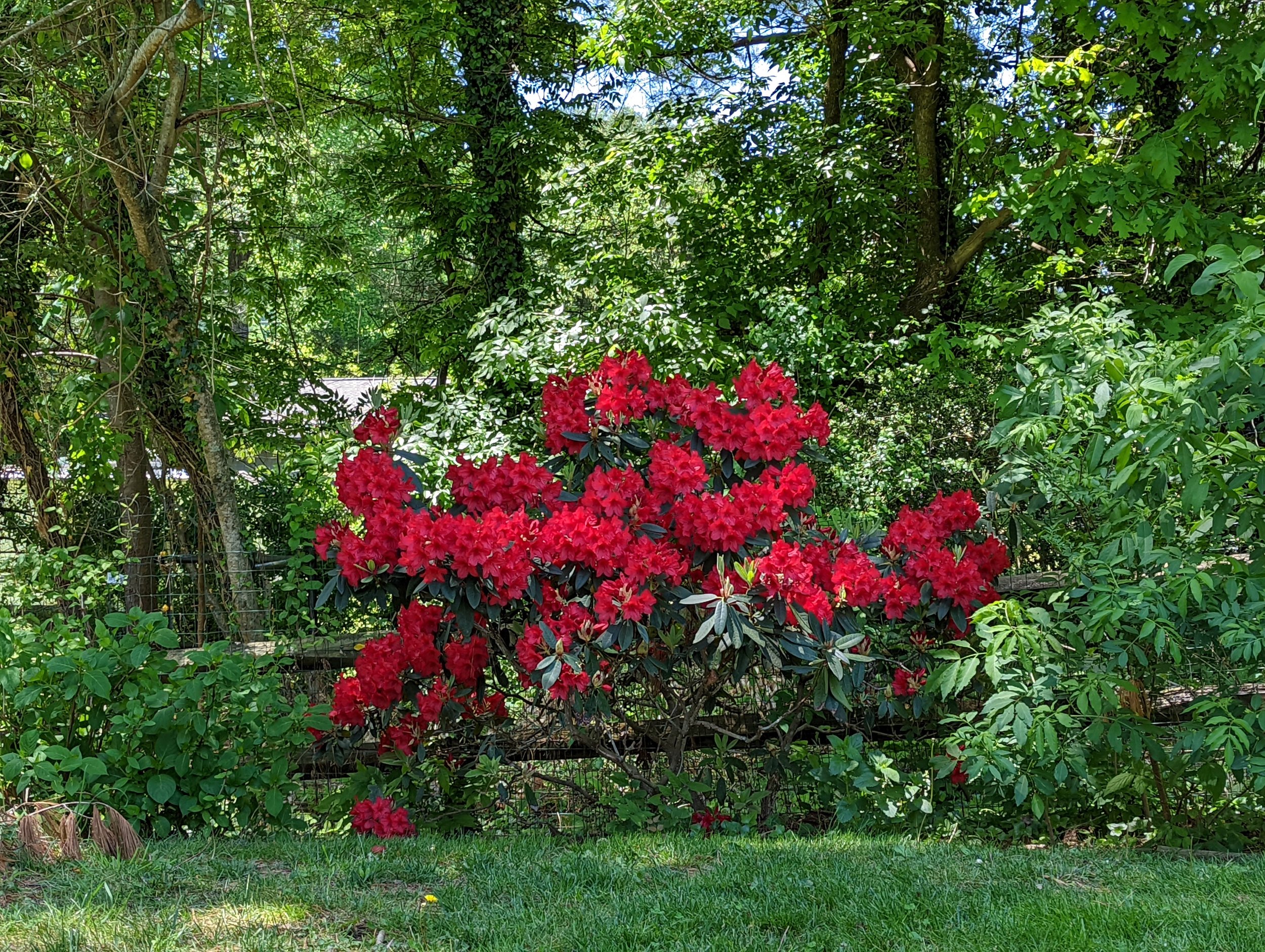Pic taken in DuPont on May 24, our first spring here, 2000 - Mountain Laurel
Wine from tomatoes? Sure - see below! Another guest article…
______________
Riesentraube Wine
by William Woys Weaver
The taste was snappy, but with a slight overtone of skunk; not exactly a wine for romance thought I, so delete the candlelit dinner scene. Color: a species of orange rosé, heavy on the orange. Would fermented Kool-Aid resemble this? No. Too dark. Definitely not grape.
My puzzled glance at the grizzly old farmer sitting opposite me elicited a toothless grin. He was thoroughly entertained, and by then the colorless schnapps he was sipping, distilled from this same strange wine, had flushed his face a mirthful pink.
“What is it?” I asked in German. Dr. Eszter Kisban of the Hungarian Academy of Sciences, who was translating this tete-a-tete back and forth from German to Hungarian, turned to me with a blank look on her face: “He said the wine is made from goat tits.” The sitting room of the farmhouse, packed full of Hungarians eager to see their first breathing American (me) exploded with gales of nervous laughter. “That is what he said,” continued Eszter apologetically, “kecske cscsu.” (More laughter.) this was my introduction to the Riesentraube tomato and vintage Riesentraube wine.
This scene transpired in the fall of 1983 when the Hungarian Academy of Sciences hosted an ethnological food conference at its mountain retreat in Matrafured, Hungary near the Slovakian border. In spite of food shortages, paper shortages, intermittent electricity, police surveillance (the communist Party was in power then), and a long list of other obstacles, my Hungarian hosts managed not only to pull off an international conference, but on the sly, also arranged for forays into the countryside. My visit to the farmer who made tomato wine was one of them.
It happened spur of the moment and at night. We ended up somewhere outside of Gyongyos, a large town mear Matrafured. The first thing I saw when I got out of the car were tomato vines trained over the picket fence that surrounded the yard. Even at night I could see the huge “puffs” of open flowers that make the Riesentraube tomato so distinctive. Later, I was shown a large platter of the tomatoes. In fact, I ate some.
This much I was able to ascertain about the tomato and its local history: no one in the area knew it by a German name, but all the farmers in the room agreed that the tomato had come from Austria “long ago.” It had been grown in the Heves region before World War II, and the German farmers who had lived there had made wine from the tomatoes, just like the wine we were drinking. When the Communists came to power they expropriated the German farms and deported the owners. This was one of those expropriated farms, and the tomatoes had been growing there when the present Hungarian owner took over the house.
I think it was this tragic story more than anything else that etched such an impression in my mind because I never forget those “goat tit” tomatoes. Certainly it would have been easy enough, on hindsight, to have gotten seed out of Hungary, but since the main purpose of my visit was to smuggle a book manuscript out of Poland, through Hungary and into Austria, my seed saving instincts were put on hold. As there was a certain degree of danger involved in my undertaking, any suspicion from border guards would have thrown that project off track.
Having just published in 1983 my study of a 19th century Pennsylvania German cookbook through the University of Pennsylvania Press, it never occurred to me that there might be a connection between the tomato wine of the Pennsylvania Dutch and the wine I tasted in Hungary. Yet evidently there is. Subsequent research has brought it all into clearer focus. In fact, Carolyn Male put out the challenge to me last year to actually recreate tomato wine from the Riesentraube tomato, and so I have. But first, something about the name.
Riesentraube simply means in German “large grape” as opposed to something that is normal size or dwarf (zwerg). That is the context of risen in German botanical literature even though it literally means giant or extra-large. It seems, however, that German growers had the Grapes of Eshcol in mind when they named this tomato. The Grapes of Eshcol are the monster grapes mentioned in the Bible, usually depicted hanging from a staff between two men. The Riesentraube produces huge clusters of tomatoes which resemble those old Biblical pictures of the Grapes of Eshcol.
To Hungarians, they look like the underbelly of a pregnant she-goat. And since each tomato has a “nipple” on the end, this has given rise to the colloquial Hungarian name. According to Hungarian agronomists, the Hungarian Goat Tit Tomato is an entirely different variety from the Riesentraube, but the two are commonly confused. Doubtless, the Riesentraube tomato exists in many places under other names equally as colorful.
My next experience with the Riesentraube tomato came through Seedsavers Exchange, where much to my surprise, I found it listed. Seed came into SSE from Curtis Choplin of North Augusta, South Carolina. His seed originated from the former East German seed bank at Gatersleben. My surprise was actually a form of startled joy because by 1993 I had found material in Pennsylvania suggesting that the Riesentraube tomato was being grown among the Pennsylvania Dutch as early as 1855 or 1856. More thorough research must be done in local German-language agricultural materials, but in the May 1857 issue of the monthly Das Bauern-Journal, published at Allentown, Pennsylvania by Mohr and Trexler, there is a recipe for tomato wine. This is the tomato wine I tasted in Hungary. The translation from Das Bauern-Journal reads as follows: Wine from Tomatoes; Simply press the juice from the fruit, cleanse it by letting it run through a linen bag, then combine this with 2 to 3 pounds of sugar to each gallon of liquid. Put this into kegs. After fermentation has taken place, you get a tasty wine.
That is a matter of opinion. Frankly, tomato wine requires a little more exactness than the above recipe would imply and considerably more patience because this is one of those wines, like dandelion wine, that does not mellow out until about the third to fifth year of aging.
I pressed Riesentraube tomatoes on September 26, 1994, with fermentation over by October 10. I can report that in my opinion the wine is nowhere ready for table use. While it begins as a bright red juice, the wine turns a muddy brown as it ferments. As of the writing of this article, the wine is still orange-brown, resembling dark apple juice, and still a bit cloudy. There is an initial sweet, toasty taste that is followed by a slight bitterness, then a lingering tomato taste on the back of the palate. The bitterness will soften with aging and the end result, like the wine I drank in Hungary, will resemble sherry. It is excellent with toasted walnuts and cheese.
My recommended method for making tomato wine is the same as that for making gooseberry wine in that the fruit is first cooked to soften it and to sterilize it of all problematic yeasts. Since gooseberries and tomatoes do not normally carry grape yeasts, it is better to eliminate all yeasts and introduce a controllable one. I also add 2 cups (500 ml) of vintage elderberry wine (1985 pressing), but any decent port will also do. I firmly believe that his helps amplify the tomato flavor as well as softens the overall character of the tomato wine. It does nothing to the color.
Lastly, in order to calculate the amount of tomatoes needed, it is important to remember that 3 to 4 pounds (1 and ½ to 2 kg) of Riesentraube tomatoes will yield about one gallon (4 liters) of liquid during crush. The water content of the tomato, like that of grapes, varies greatly due to weather conditions and time of harvest. I believe that the end-of-season tomatoes I used last year had far too much acid and much less flavor than those I might have harvested during the heat of August. This is a consideration that only trial and error will resolve, given the great variation in growing conditions throughout the country. The accompanying recipe (page 5) follows the basic outline of the original 1857 recipe, but greatly expands on the implied steps and procedures.
Note: The original recipe calls for oak kegs. Aging the wine in oak will definitely alter its taste and character, probably improving the toasty or smoky quality of its flavor. Since I was not able to experiment with oak, this aspect of the recipe remains speculative. However, the Hungarian wine that I tasted in 1983 had been aged in oak and was superior to what I have thus far produced. (Riesentraube tomato seeds are available to members of Seedsavers Exchange and to the general public from Southern Exposure Seed Exchange, Ed. Note)
Tomato Wine: Weaver’s Method
1 gallon (4 liters) tomato juice
3 lbs. (1 ½ kg) white granulated sugar
2 cups (500 ml) elderberry wine or port (optional)
1 teaspoon dry yeast
To make the juice, quarter the fruit and remove the seeds. Put the fruit in a deep, non-reactive stewing pan (preferably stainless steel) and pour over this 2 quarts (2 liters) of boiling bottled spring water. Do not use chemically treated water. Cover and bring the fruit to a slow boil (about 20 minutes), then remove the pan from the heat.
Pour the fruit into a strainer and gently press out all of the pulp and liquid. Measure out the juice. To each gallon (4 liters), add 3 pounds (1 ½ kg) of sugar, mixing the juice and sugar together in a large, clean 5-gallon (20 liter) crock. Add the optional elderberry wine or port, and when the mixture cools to room temperature, add the yeast. For a quantity of liquid over 10 gallons (40 liters) add 1 tablespoon of dry yeast, but not more.
Cover the crock with cheesecloth and set the wine aside in a warm place to ferment. When fermentation ceases (this will depend on weather conditions as much as room temperature), transfer the wine to sanitized half-gallon jugs. If the wine appears a little frisky, do not cap the jugs or they will explode. Let the wine rest until it is perfectly still, then cap the jugs and let the wine age. As it ages, sediment will accumulate in the bottom on the jugs and the wine will gradually clarify. Once it is clear it maybe bottled up into wine bottles, corked and put down to age like any grape wine.
________________
Tomatoes really can be used for anything, it seems! I’ve had tomato desserts, tomato pesto, tomato ice cream - and now we have a recipe, above, for tomato wine! I don’t think I’ll be making it any time soon though!
Blossom sitting on fern, Pisgah Forest, May 2020. Another example of proof we made the right move at the right time!

























